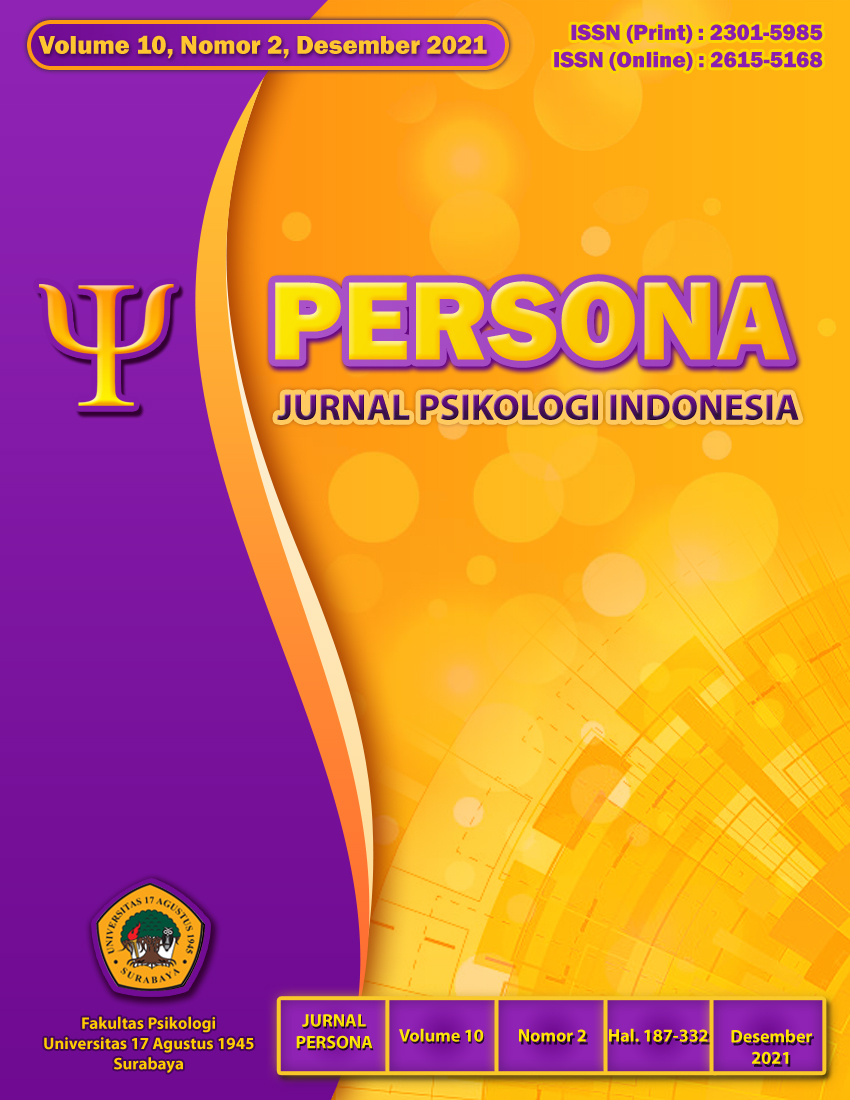Adaptasi dan validasi the Intolerance of Uncertainty Scale-12 pada individu yang telah menikah selama pandemi Covid-19
DOI:
https://doi.org/10.30996/persona.v10i2.5471Keywords:
adaptation, Indonesia, IUS-12, married individuals, validationAbstract
Abstract
This study aims to adapt and validate the Intolerance of Uncertainty Scale-12 in a group of married individuals in Indonesia during the pandemic of Covid-19. Getting married is a significant transitional stage for individuals. Previous research has shown that married couples experience anxiety over their lives and family as a response to uncertain conditions. The Intolerance of Uncertainty Scale-12 is a scale to measure individual responses to uncertainty. However, as the best of researcher’s knowledge, there was no Indonesian version that has been culturally adapted and validated. This research used quantitative method and 203 participants participated in this study through snowball sampling. Data analysis utilized factor analysis with the exploratory factor analysis (EFA) and confirmatory factor analysis (CFA) to measure construct validity, Aiken’s V to measure content validity, and Cronbach’s Alpha to measure reliability. Results showed that model fit at the 4 factors according to χ2, RMSEA, SRMSR, CFI, and TLI scores. Those aspects are negative perception of uncertainty, desire for certainty, behavioral inhibition due to uncertainty, and helplessness toward uncertainty. Furthermore, explanation about the factors formation will be discussed.
Keywords: adaptation, Indonesia, IUS-12, married individuals, validation
Abstrak
Penelitian ini bertujuan untuk mengadaptasi dan memvalidasi the Intolerance of Uncertainty Scale-12 pada kelompok individu yang telah menikah di Indonesia selama pandemi Covid-19. Menikah merupakan tahap transisi yang cukup signifikan bagi individu. Penelitian sebelumnya telah menunjukkan bahwa pasangan menikah mengalami kecemasan sebagai respon atas ketidakpastian. The Intolerance of Uncertainty Scale-12 merupakan skala untuk mengukur respon individu atas ketidakpastian namun sebatas pengetahuan peneliti, belum ada versi Bahasa Indonesia yang telah melalui proses adaptasi dan validasi. Penelitian ini menggunakan metode kuantitatif dengan partisipan berjumlah 203 orang yang diperoleh dengan snowball sampling. Analisis data menggunakan analisis faktor dengan exploratory factor analysis (EFA) dan confirmatory factor analysis (CFA) untuk mengukur validitas konstruk, Aiken’s V untuk mengukur validitas isi, dan Cronbach’s Alpha untuk mengukur reliabilitas. Hasil analisis menunjukkan kesesuaian model dengan 4 faktor (aspek) didasarkan pada skor χ2, RMSEA, SRMSR, CFI, dan TLI. Aspek tersebut yaitu persepsi negatif terhadap ketidakpastian, hasrat akan kepastian, tindakan terhalangi oleh ketidakpastian, dan ketidakberdayaan menghadapi ketidakpastian. Lebih jauh lagi, terdapat penjelasan mengenai faktor-faktor yang terbentuk.
Kata kunci: adaptasi, individu menikah, Indonesia, IUS-12, validasi
Downloads
Downloads
Published
Issue
Section
License
The author who will publish the manuscript at Persona: Jurnal Psikologi Indonesia, agree to the following terms:
1. Authors retain copyright and grant the journal right of first publication with the work simultaneously licensed under a Creative Commons Attribution ShareAlike License that allows others to share the work with an acknowledgment of the work's authorship and initial publication in this journal.
2. Authors are able to enter into separate, additional contractual arrangements for the non-exclusive distribution of the journal's published version of the work (e.g., post it to an institutional repository or publish it in a book), with an acknowledgment of its initial publication in this journal.
3. Authors are permitted and encouraged to post their work online (e.g., in institutional repositories, pre-prints sites or on their website) prior to and during the submission process, as it can lead to productive exchanges, as well as earlier and greater dissemination of published work






